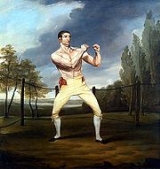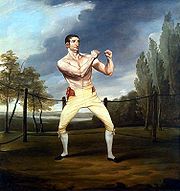
Thomas Douglas Guest
Encyclopedia
Thomas Douglas Guest was a British
historical
- and portrait
painter. He studied at the schools of the Royal Academy
, and in 1803 sent his first contribution to its exhibitions - a portrait of the sculptor Joseph Wilton
. Next year he was represented by Madonna and Child, and in 1805 gained the gold medal for historical painting, the subject being Bearing the Dead Body of Patroclus
to the Camp, Achilles
's Grief. This work was exhibited at the British Institution
in 1807. In the years up to 1839 he continued to contribute paintings to the Academy (see list below). Besides those, he exhibited several pictures at the British Institution and a few at the Society of British Artists. He also painted in 1809 a large picture of 'The Transfiguration', which he presented as an altar-piece to St. Thomas's Church, Salisbury
. In 1829 Guest published An Inquiry into the Causes of the Decline of Historical Painting. In 1839 he sent two small works to the exhibition of the British Institution, and there is no further notice of him.

United Kingdom
The United Kingdom of Great Britain and Northern IrelandIn the United Kingdom and Dependencies, other languages have been officially recognised as legitimate autochthonous languages under the European Charter for Regional or Minority Languages...
historical
History painting
History painting is a genre in painting defined by subject matter rather than an artistic style, depicting a moment in a narrative story, rather than a static subject such as a portrait...
- and portrait
Portrait painting
Portrait painting is a genre in painting, where the intent is to depict the visual appearance of the subject. Beside human beings, animals, pets and even inanimate objects can be chosen as the subject for a portrait...
painter. He studied at the schools of the Royal Academy
Royal Academy
The Royal Academy of Arts is an art institution based in Burlington House on Piccadilly, London. The Royal Academy of Arts has a unique position in being an independent, privately funded institution led by eminent artists and architects whose purpose is to promote the creation, enjoyment and...
, and in 1803 sent his first contribution to its exhibitions - a portrait of the sculptor Joseph Wilton
Joseph Wilton
Joseph Wilton was an English sculptor and one of the founding members of the Royal Academy in 1768 .Born to a wealthy family in London, Wilton trained in Flanders, Paris, Rome and Florence...
. Next year he was represented by Madonna and Child, and in 1805 gained the gold medal for historical painting, the subject being Bearing the Dead Body of Patroclus
Patroclus
In Greek mythology, as recorded in the Iliad by Homer, Patroclus, or Patroklos , was the son of Menoetius, grandson of Actor, King of Opus, and was Achilles' beloved comrade and brother-in-arms....
to the Camp, Achilles
Achilles
In Greek mythology, Achilles was a Greek hero of the Trojan War, the central character and the greatest warrior of Homer's Iliad.Plato named Achilles the handsomest of the heroes assembled against Troy....
's Grief. This work was exhibited at the British Institution
British Institution
The British Institution was a private 19th-century society in London formed to exhibit the works of living and dead artists; it was also known as the Pall Mall Picture Galleries or the British Gallery...
in 1807. In the years up to 1839 he continued to contribute paintings to the Academy (see list below). Besides those, he exhibited several pictures at the British Institution and a few at the Society of British Artists. He also painted in 1809 a large picture of 'The Transfiguration', which he presented as an altar-piece to St. Thomas's Church, Salisbury
Salisbury
Salisbury is a cathedral city in Wiltshire, England and the only city in the county. It is the second largest settlement in the county...
. In 1829 Guest published An Inquiry into the Causes of the Decline of Historical Painting. In 1839 he sent two small works to the exhibition of the British Institution, and there is no further notice of him.
Works

- Portrait of the sculptor Joseph WiltonJoseph WiltonJoseph Wilton was an English sculptor and one of the founding members of the Royal Academy in 1768 .Born to a wealthy family in London, Wilton trained in Flanders, Paris, Rome and Florence...
, (1803) - Madonna and Child (1804)
- Bearing the Dead Body of PatroclusPatroclusIn Greek mythology, as recorded in the Iliad by Homer, Patroclus, or Patroklos , was the son of Menoetius, grandson of Actor, King of Opus, and was Achilles' beloved comrade and brother-in-arms....
to the Camp, AchillesAchillesIn Greek mythology, Achilles was a Greek hero of the Trojan War, the central character and the greatest warrior of Homer's Iliad.Plato named Achilles the handsomest of the heroes assembled against Troy....
's Grief (1805) - PenelopePenelopeIn Homer's Odyssey, Penelope is the faithful wife of Odysseus, who keeps her suitors at bay in his long absence and is eventually reunited with him....
unravelling the web (1806) - CupidCupidIn Roman mythology, Cupid is the god of desire, affection and erotic love. He is the son of the goddess Venus and the god Mars. His Greek counterpart is Eros...
wrestling with PanPan (mythology)Pan , in Greek religion and mythology, is the god of the wild, shepherds and flocks, nature, of mountain wilds, hunting and rustic music, as well as the companion of the nymphs. His name originates within the Greek language, from the word paein , meaning "to pasture." He has the hindquarters, legs,...
; an allegory' (1808) - VenusVenusVenus is the second planet from the Sun, orbiting it every 224.7 Earth days. The planet is named after Venus, the Roman goddess of love and beauty. After the Moon, it is the brightest natural object in the night sky, reaching an apparent magnitude of −4.6, bright enough to cast shadows...
recumbent and Cupids (1809) - ClorindaClorindaClorinda may refer to:* Clorinda Corradi , noted Italian opera contralto* Clorinda Matto de Turner , Peruvian writer* Clorinda, a character in the epic poem Jerusalem Delivered by Torquato Tasso...
(1811) - Cupid and PsycheCupid and PsycheCupid and Psyche , is a legend that first appeared as a digressionary story told by an old woman in Lucius Apuleius' novel, The Golden Ass, written in the 2nd century CE. Apuleius likely used an earlier tale as the basis for his story, modifying it to suit the thematic needs of his novel.It has...
(1811) - The Second Appearance of the Messiah (1834)
- The Judgement of HerculesHerculesHercules is the Roman name for Greek demigod Heracles, son of Zeus , and the mortal Alcmene...
(1834) - The Prism (1838)
- PhaetonPhaëtonIn Greek mythology, Phaëton or Phaethon was the son of Helios and the Oceanid Clymene. Alternate, less common genealogies make him a son of Clymenus by Merope, of Helios and Rhode or of Helios and Prote....
driving the Chariot of the Sun (1838)

